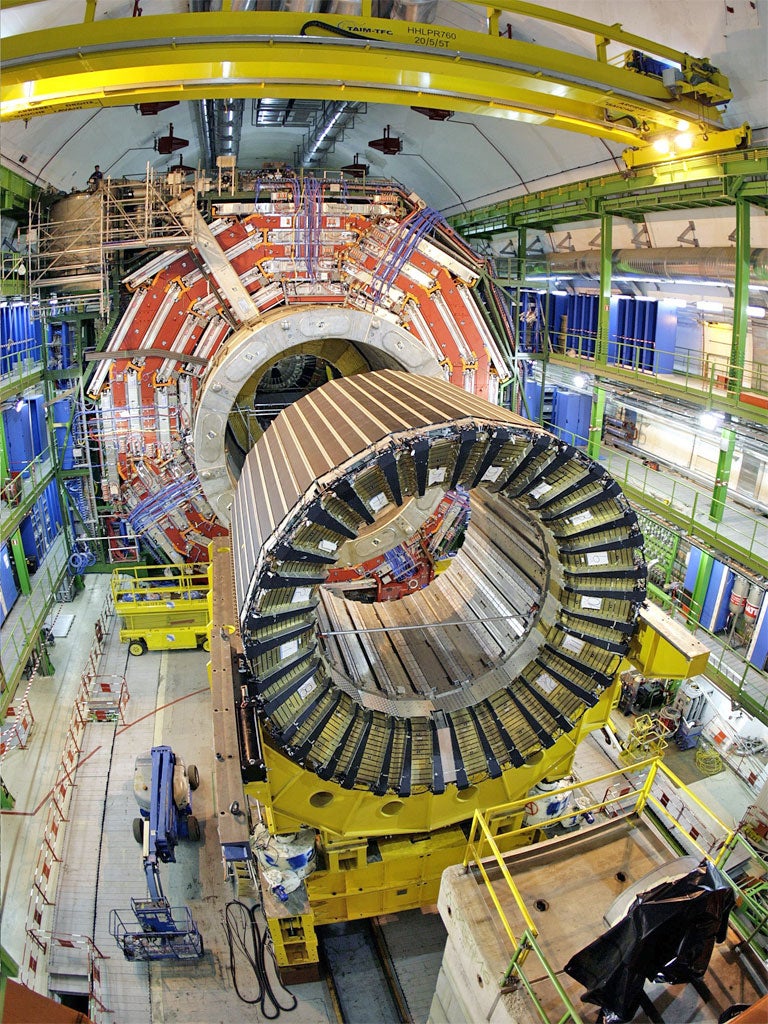Has science found the 'God particle'?
Maybe, say nuclear scientists... but if we could just have a few months to make sure

European nuclear research scientists say they are close to discovering the elusive Higgs boson, the "God particle" that confers mass on matter and is thought to be one of the building blocks to the universe. But they are still some way from confirming the existence of a sub-atomic particle that is one of the cornerstones of modern physics.
Click HERE to view graphic
Despite excited reports yesterday morning on the BBC that the particle has been "glimpsed", the Cern laboratory in Geneva yesterday merely confirmed that measurements by its £5bn Large Hadron Collider have come closer than previous searches to detecting the sub-atomic particle whose existence was first hypothesised in the 1960s.
Scientists said they have eliminated 95 per cent of the energy range where the Higgs may have been hiding, but are not yet ready to exclude the possibility that what they have detected is merely background noise rather than the real thing. They said that final, definite proof will now have to wait until 2012.
Professor Rolf-Dieter Heuer, head of Cern, urged: "Please be prudent. We have not found it yet. Stay tuned for next year."
Professor Themis Bowcock, head of particle physics at the University of Liverpool, said: "If the Higgs observation is confirmed, this really will be one of the discoveries of the century."
Dr Stephen Haywood, head of the Atlas Group at the STFC Rutherford Appleton Laboratory, said: "This is what many of us have been working towards for 20 years. This is just the start."
Q&A: Key to the sub-atomic world
Q. What is the Higgs boson?
A. It is a sub-atomic particle, or "boson", that was first proposed theoretically in the 1960s by Professor Peter Higgs of Edinburgh University. He suggested that in order for matter to have mass, it must be influenced by a hypothetical particle that creates a field, called the Higgs field, which spreads throughout the Universe.
No one, however, was able to detect the Higgs boson because of the energy levels needed to collide other sub-atomic particle together in order to winkle it out.
Q. How does the Higgs work?
A. The most celebrated analogy is to compare the Higgs particle to a party activist as a famous politician, perhaps a former female Prime Minister, moves through a room full of activists all wishing to see or talk to her.
The movement of the politician is influenced by how many other people cluster around her. The Higgs particles are like these party activists and the former Prime Minister is like matter itself.
The more interaction there is between the Higgs particles and matter, the more mass that this particular matter possesses – and the heavier it is in gravity.
Q. Why is the Higgs particle so important?
A. To try to understand what is going on at the sub-atomic level, physicists have come up with a theory called the Standard Model. It explains three of the fundamental forces that interact at the nuclear level: the electromagnetic force, the strong nuclear force and the weak nuclear force. The Higgs particle is part of this Standard Model, which is why it was proposed in the first place. Frustratingly, though, it is the only boson or particle predicted by the Standard Model that has not so far been detected. This may be because it is difficult to detect (which is undoubtedly is) or that it doesn't exit.
Q. Why is the Higgs particle so difficult to find?
A. To find sub-atomic particles, it is necessary to collide other particles together at high energies using a machine such as the £5bn Large Hadron Collider, which accelerates sub-atomic particles called hadrons at 99.9999991 per cent of the speed of light. Sensitive detectors at the sites where the hadrons collide are then designed to monitor the tell-tale signs of a Higgs particle. There are two detectors or experiments trying to find the Higgs, one is called Atlas the other is called CMS and both are searching at similar energy levels. Unfortunately, there is a lot of "noise" coming from other particles and collisions that can mask the existence of the Higgs. Sophisticated statistical analysis is the only way of improving the certainty that a Higgs has truly been detected.
Q. What if the Higgs does not exist?
A. Then it would mean that the Standard Model is not correct, or at least not correct in the way it has been understood. Failing to find the Higgs has been said by CERN scientists to be an even more intriguing event than actually discoving its existence – although particle physicists would say that given that they have built a hugely expensive machine largely on the belief that it exists. The non-existence of the Higgs would mean that physicists would have to go back to the drawing board in terms of trying to understand what is going on at the sub-atomic level.
Join our commenting forum
Join thought-provoking conversations, follow other Independent readers and see their replies
Comments
Bookmark popover
Removed from bookmarks